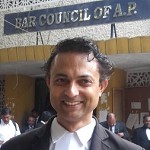Evidence
 adv. rajeev ( rajoo )
(Querist) 20 May 2018
This query is : Resolved
adv. rajeev ( rajoo )
(Querist) 20 May 2018
This query is : Resolved
Against my client his wife has filed 498A case. Elders of the samaja tried to solve the dispute between husband and wife. Wife has admiited her mistakes and executed a letter infront of the elders of the samaja that she has done a mistakes and will co-operate with the husand and his family members. All the meetings were recorded by the husband thru., mobile and stored in CD. Now 498A case is for cross examination of the wife. Husband wants to confront the CD to the wife in a cross examination. So under what section of Cr.P.C. husband can file an application seeking permission of the court to confront the CD to wife. Any judgments please let me know. Thanks in advance.
Read more at: https://www.lawyersclubindia.com/forum/Admissability-of-cd-in-criminal-case-178519.asp
 Anil Satyagraha
(Expert) 21 May 2018
Anil Satyagraha
(Expert) 21 May 2018
May-21-2018 Mon, 01:10 PM
PETITION TO RECEIVE DOCUMENT(S) AND TO MARK EXHIBITS
FILED U/SS 294, 302, inter alia CRPC R/W CRIMINAL RULES OF PRACTICE & CIRCULAR ORDER R.58
SECTION § 294. NO FORMAL PROOF OF CERTAIN DOCUMENTS.
(1) Where any document is filed before any Court by the prosecution or the accused, the particulars of every such document shall be included in a list and the prosecution or the accused, as the case may be, or the pleader for the prosecution or the accused, if any, shall be called upon to admit or deny the genuineness of each such document.
(2) The list of documents shall be in such form as may be prescribed by the State Government.
(3) Where the genuineness of any document is not disputed, such document may be read in evidence in any inquiry, trial or other proceeding under this Code without proof of the signature of the person to whom it purports to be signed: Provided that the Court may, in its discretion, require such signature to be proved.
THE CRIMINAL RULES OF PRACTICE AND CIRCULAR ORDERS, 1990
R.58 MARKING OF EXHIBITS:-
(1) Exhibits admitted in evidence shall be marked as follows:-
(i) If filed by the prosecution with the capital letter ‘P’ followed by a numeral, P1, P2,P3 and the like;
(ii) If filed by defence with the capital letter ‘D’ followed by a numeral, D1, D2, D3 and the like;
(iii) in case of Court exhibits with the capital letter ‘C’ followed by a numeral C1, C2, C3 and the like;
(2) All the exhibits filed by the several accused shall be marked consecutively.
All material objects shall be marked in Arabic numbers in continuous series as M.O. 1, M.O.2 and M.O.3 and the like, whether exhibited by the prosecution or the defence or the Court.
OBJECT OF LAW TO ADMIT EVIDENCE SUPPORTS CAUSE OF PETITIONER
IN THE MATTER OF Shamsher Singh Verma v. State of Haryana, 2015 0 Supreme(SC) 1073 , the Hon'ble SUPREME COURT OF INDIA speaking through Learned Dipak Misra, Prafulla C. Pant, JJ. vide CRIMINAL APPEAL NO. 1525 OF 2015 (Arising out of S.L.P. (Crl.) No. 9151 of 2015) as Decided On : 24-11-2015, has held —
“(¶ 11 ) — The object of Section 294 CrPC is to accelerate pace of trial by avoiding the time being wasted by the parties in recording the unnecessary evidence. Where genuineness of any document is admitted, or its formal proof is dispensed with, the same may be read in evidence. Word “document” is defined in Section 3 of the Indian Evidence Act, 1872, as under:-
“ ‘Document’ means any matter expressed or described upon any substance by means of letters, figures or marks, or by more than one of those means, intended to be used, or which may be used, for the purpose of recording that matter.
ILLUSTRATION
A writing is a document;
Words printed, lithographed or photographed are documents; A map or plan is a document;
An inscription on a metal plate or stone is a document; A caricature is a document.”
(¶ 12) — In R.M. Malkani vs. State of Maharashtra, (1973) 1 SCC 471 : 1973 (2) SCR 417 this Court has observed that tape recorded conversation is admissible provided first the conversation is relevant to the matters in issue; secondly, there is identification of the voice; and, thirdly, the accuracy of the tape recorded conversation is proved by eliminating the possibility of erasing the tape record.
(¶ 13) — In Ziyauddin Barhanuddin Bukhari vs. Brijmohan Ramdass Mehra and others, (1976) 2 SCC 17 : 1975 (Supp) SCR 281 it was held by this Court that tape-records of speeches were “documents”, as defined by Section 3 of the Evidence Act, which stood on no different footing than photographs, and that they were admissible in evidence on satisfying the following conditions:
“(a) The voice of the person alleged to be speaking must be duly identified by the maker of the record or by others who know it.
(b) Accuracy of what was actually recorded had to be proved by the maker of the record and satisfactory evidence, direct or circumstantial, had to be there so as to rule out possibilities of tampering with the record.
(c) The subject-matter recorded had to be shown to be relevant according to rules of relevancy found in the Evidence Act.”
(¶ 14) — In view of the definition of ‘document’ in Evidence Act, and the law laid down by this Court, as discussed above, we hold that the compact disc is also a document. It is not necessary for the court to obtain admission or denial on a document under sub-section (1) to Section 294 CrPC personally from the accused or complainant or the witness. The endorsement of admission or denial made by the counsel for defence, on the document filed by the prosecution or on the application/report with which same is filed, is sufficient compliance of Section 294 CrPC. Similarly on a document filed by the defence, endorsement of admission or denial by the public prosecutor is sufficient and defence will have to prove the document if not admitted by the prosecution. In case it is admitted, it need not be formally proved, and can be read in evidence. In a complaint case such an endorsement can be made by the counsel for the complainant in respect of document filed by the defence.”
IN THE MATTER OF Veerla Venkateswera Rao v. State OF A.P., Rep.by its P.P., 2005 (1) ALT(Cri) 305 , the Hon'ble Andhra Pradesh High Court speaking through learned P.S.NARAYANA, while adjudicating a matter involving CRIMINAL RULES OF PRACTICE AND CIRCULAR ORDER :R.58 as decided On : 09-22-04, has held —
“(¶ 13 ) — AS can be seen from the material available on record, Ex. P-8 the post mortem certificate is shown to have been marked. The doctor concerned to Ex. P-8 had not been examined nor any other medical evidence was produced in this regards. On a perusal of the records i. e. , on Ex. P- 8, it is not shown through which witness the same was marked and there was no endorsement made by the Court. Rule 58 of Criminal Rules of practice 1990 dealing with marking of exhibits reads:
"Rule 58-Marking of exhibits:
(1) Exhibits admitted in evidence shall be marked as follows:
(i) if filed by the prosecution with the capital letter "p" followed by a numeral, P-1, P-2, P-3 and the like;
(ii) if filed by defence with the capital letter "d" followed by a numeral, d-1. D-2, D-3 and the like; (iii) in case of Court exhibits with the capital letter "c" followed by a numeral, C-1, C-2, C-3 and the like
(2) All the exhibits filed by the several accused shall be marked consecutively.
All material objects shall be marked in arabic numbers in continuous series as M. O. 1, M. O. 2 and M. O. 3 and the like, whether exhibited by the prosecution or the defence or the Court. "
xxx
”
AGAIN, in the matter of Thumma Babul Reddy v. State of A.P., 2011 (0) CrLJ 2991 , the Hon'ble HIGH COURT OF JUDICATURE, ANDHRA PRADESH AT HYDERABAD speaking through learned K.C. BHANU and N.R.L. NAGESWARA RAG, JJ. vide Criminal Appeal No. 795 of 2007 as Decided on : 21-12-2010, deliberated on the importance of marking evidence exhibits in accordance with law, has held —
“(¶ 13 ) —
xxx
Rule 58 of Criminal Rules of Practice and Circular Orders, 1990 Inter alia provides that exhibits admitted in evidence shall be marked with capital letter P followed by a numerical P-1, P-2, P-3 and the like if they are filed by prosecution.
Section 62 of Evidence Act defines primary evidence which means the document itself produced for inspection of Court. Thereafter the contents of a document have to be proved by admissible evidence but not necessarily by the author of document in view of Section 293 of Code of Criminal Procedure. Under Section 64 of Evidence Act, documents must be proved by primary evidence except in the cases hereinafter mentioned. When the document is proved to have been issued, it follows the exhibit number.
From the above provisions, it is clear that a document has to be exhibited in the Court of Law.
xxx
It is needless to observe, that it is the imperative duty of prosecution to mark the document in accordance with law. If the prosecutor for obvious reasons, has not tendered the document, the Court is not helpless. Judge is not a mere spectator to watch the game in the field. Court ,has to bring the document on record as an exhibit as per the provisions of Evidence Act.
xxx
”
~~~~~~~~~~
Anil @ Satyagraha.com
P: +91 7095 776633
P: +91 8019 291111
Disclaimer Notice: This message and any files transmitted with it are for the sole use of the intended recipient(s) and may contain confidential and privileged information. This message or any part of it is not construed to be Legal Advice. For legal help, kindly contact a lawyer that specializes in the area of your concern.
If you are not the intended recipient of the message, please contact the sender by reply e-mail and destroy all copies of the original message.
Any unauthorized review, use, disclosure, dissemination, forwarding, printing or copying of this email or any action taken in reliance on this e-mail is strictly prohibited and may be unlawful.
 Anil Satyagraha
(Expert) 21 May 2018
Anil Satyagraha
(Expert) 21 May 2018
TABLE OF AUTHORITIES
STATUS
THE CODE OF CRIMINAL PROCEDURE, 1973
CRPC § 294 — NO FORMAL PROOF OF CERTAIN DOCUMENTS
THE CRIMINAL RULES OF PRACTICE AND CIRCULAR ORDERS, 1990
R.58 MARKING OF EXHIBITS:-
Caselaw
Shamsher Singh Verma v. State of Haryana, 2015 0 Supreme(SC) 1073 13
Thumma Babul Reddy v. State of A.P., 2011 (0) CrLJ 2991 15
Veerla Venkateswera Rao v. State OF A.P., Rep.by its P.P., 2005 (1) ALT(Cri) 305 14
~~~~~~~~~~
Anil @Satyagraha.com
P: +91 7095 776633
P: +91 8019 291111
Disclaimer Notice: This Message and any files transmitted with it are for the sole use of the intended recipient(s) and may contain confidential and privileged information. This message or any part of it is not construed to be Legal Advice. For legal help, kindly contact a lawyer that specializes in the area of your concern.
If you are not the intended recipient, please contact the sender by reply Message and destroy all copies of the original message.
Any unauthorized review, use, disclosure, dissemination, forwarding, printing or copying of this message or any action taken in reliance on this Message is strictly prohibited and may be unlawful.
